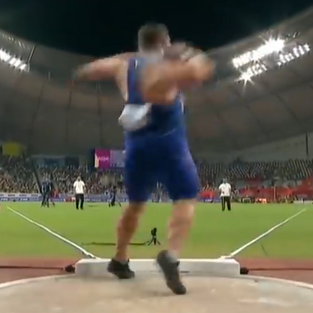The Block Leg
- Throws University

- Feb 24, 2020
- 5 min read
You hear the term “block” used frequently but the premise and idea is abstract. What does “block” mean? What does it refer to? Is it in reference to the arm? The leg? This is an area of consistent confusion, not only amongst throwers but even amongst throws coaches!
The History
Through various discussions and research, the term “block” was used to describe the weak side leg and arm when working through a discus spin or glide in the shot put. The original usage of the word was to describe a holding position or a stopping position as the dominant side would shift past the stopping position.

The greatest discus thrower ever, Al Oerter, described it as “sticking” the left leg at the front while the shoulders would square up to the sector and the right shoulder would rip across in the finish. This sticking action was done through a flat left foot.
The question becomes, how does the block leg get there?
Action of Block Leg
(ThrowsU will create a better term...any ideas?)
For the purpose of this article, the block side will refer entirely to the left leg of a right-handed thrower. This will make it easier for understanding and over 85% of throwers are right-handed (sorry Lincoln and Noah and Jacob Lemmon).
We will be referring specifically to the movement of the left leg during the SPIN in the shot put.
Out of the Back
As a shot putter winds in their spin, they will load the left leg and then shift their energy to the right side, generating a sense of tension and stretching. The thrower will push their chest over their left leg after the winding period, they will rotate the left side, then sweep with the right leg.
When the right leg passes the left knee or block leg, the left knee will be facing the center or left of the sector and will drop toward the front. At this point, the right leg will sweep to the center and the thrower will “pull” off the left leg by having an ACTIVE left ANKLE joint but a passive left knee!
This is THE hardest point of the throw. Many throwers in the spin feel the need to extend their left knee to get off of the left out the back. Instead, keep the knee slightly bent while the ankle flexes forward!
Into the Middle
When the right side grounds in the middle, the left foot should stay in line with the left knee or slightly lower. Ryan Crouser’s left foot tends to be SLIGHTLY lower than the left knee as was Reese Hoffa’s while Joe Kovacs holds his left foot in line with the knee.
If the foot creeps higher than the knee, it is ok as long as the athlete has an open left hip when the foot grounds. Justin Rodhe tended to have a higher left foot than his knee joint but his left hip would be open upon grounding, creating tremendous tension through his trunk.
As the left knee passes the right knee, the left knee should be wide from the right knee. This sparks tremendous tension from the left hip, across the trunk, into the right shoulder. This stretching will generate a greater contraction through the finish.
I believe this is the second most misinformed/poorly coached position in the spin. Many coaches STILL teach the athlete to pinch their left knee to the right knee, minimizing rotational energy while leading to an early transfer into the left leg. The left knee should be held WIDER to the front!
BONUS: This is where we refer to the left leg as the sweep leg! The right leg sweeps out of the back and the left leg becomes the prime mover through the middle. When the right grounds in the center, the left leg SWEEPS to the front while the upper body holds. This sweeping creates a tremendous means of acceleration.
The Front
Here is where the misconception of the “block” leg has developed. It is imperative to understand that the left leg remains semi-bent till the very FINAL second of release. Holding a bent left leg is not a block, it acts almost more like a trebuchet or piston.

The bent left is held while 70% of the weight is held over the right side by having the spine angle shifted toward the back of the circle. The left leg remains BENT and the left knee should be facing inside the right sector or center sector. Ideally, the left heel will ground FLAT!

The flat left is a solid cue for multiple reasons. This cue triggers some throwers to get their left leg down faster THUS leading to a longer period in double support. This flat heel also triggers the quad and glutes to decelerate the weak side while the right side becomes the prime mover!
As the left holds flat, the right side rotates on a bent right leg and the right shoulder smashes around the body! It is important to recognize that some athletes hold a flat left leg longer than others.
I believe it is optimal to hold the left heel down longer but I also believe you can throw extremely far with the left up early. Joe Kovacs had his left heel high upon grounding on 22.91 and still won the world title and has the farthest throw ever for a drug-free athlete. Could Joe hold it down longer? For sure. Does it hold him back? Probably not.
It should be coached to get to a flat left foot and hold that as the right side rotates. That is the definition of the “block” and that is how Al Oerter became the greatest discus thrower to ever walk the planet. That flat left enables tremendous rotation on the finish.
As the weight of the thrower TRANSFERS forward, the left leg will slowly extend, the thrower will come off the left leg and the right shoulder will rotate around the finish and back into the circle for the save! The flat left heel enables the thrower to keep their right heel lower on the reverse as well.

The block leg is one of the most misunderstood concepts in the sport of throwing. By executing it effectively with proper ankle flexion out of the back, utilizing a left leg sweep to the front and holding a flat heel on the finish, the spinner will add tremendous distance to the throw.
Do you struggle with the left leg during the spin? Is this a problem area in your own throwing that you need to improve upon. Pick up a technical analysis today and get those gains transferring into longer distances!

"Our aim is to provide concise and concrete education and training on the throws, helping coaches and athletes learn what they need to do to succeed and become champions."
- Dane and Trevor






















Does anything change for the discus?